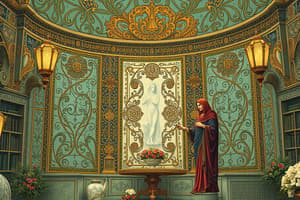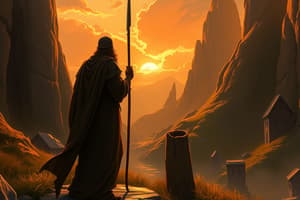Podcast
Questions and Answers
What was a primary characteristic of Roman sculptures during the reign of Augustus?
What was a primary characteristic of Roman sculptures during the reign of Augustus?
- A focus on playful expressions
- Introspective moods
- Solemn and unsmiling poses (correct)
- Exaggerated facial features
Which statement best describes the realism in Roman relief sculptures?
Which statement best describes the realism in Roman relief sculptures?
- They were dominated by emotional expressions.
- They emphasized accurate representation of historical events. (correct)
- They primarily used mythical themes.
- They focused mainly on abstract forms.
How did Roman sculptors influence the production of statues?
How did Roman sculptors influence the production of statues?
- By focusing solely on local themes.
- By creating unique original works only.
- By heavily copying Greek sculptures. (correct)
- By avoiding the use of marble.
What aspect of Roman relief sculpture differed from that of the Greeks?
What aspect of Roman relief sculpture differed from that of the Greeks?
Which of the following was not a characteristic of Roman sculpture?
Which of the following was not a characteristic of Roman sculpture?
What was the new purpose Roman artists brought to relief sculpture?
What was the new purpose Roman artists brought to relief sculpture?
What was one of the artistic legacies of Roman sculpture?
What was one of the artistic legacies of Roman sculpture?
In what way did the Romans differ from the Greeks in recording history through sculpture?
In what way did the Romans differ from the Greeks in recording history through sculpture?
What were the three most common types of sarcophagi during the transition from cremation to burial in Rome?
What were the three most common types of sarcophagi during the transition from cremation to burial in Rome?
Which material was most commonly used for the most expensive sarcophagi?
Which material was most commonly used for the most expensive sarcophagi?
What genre of painting did Romans innovate that the Greeks showed little interest in?
What genre of painting did Romans innovate that the Greeks showed little interest in?
What was a notable technique that Roman painters developed, albeit in a crude form?
What was a notable technique that Roman painters developed, albeit in a crude form?
Which types of scenes and motifs were commonly depicted on sarcophagi?
Which types of scenes and motifs were commonly depicted on sarcophagi?
Which event helped preserve most surviving Roman paintings?
Which event helped preserve most surviving Roman paintings?
Why is the replication of Greek statues by Roman artists considered significant?
Why is the replication of Greek statues by Roman artists considered significant?
Who were typically the creators of Roman decorative murals?
Who were typically the creators of Roman decorative murals?
What characterized the 'Severe Style' of the Early Classical Period in sculpture?
What characterized the 'Severe Style' of the Early Classical Period in sculpture?
Which work is an example of the Early Classical Period?
Which work is an example of the Early Classical Period?
What innovation in painting emerged during the Classical Period?
What innovation in painting emerged during the Classical Period?
Which period is known for producing the first female nude in sculpture?
Which period is known for producing the first female nude in sculpture?
What significant conflict impacted Athens and Sparta during the Classical Period?
What significant conflict impacted Athens and Sparta during the Classical Period?
Which artist's work is associated with the concept of idealization in the High Classical Period?
Which artist's work is associated with the concept of idealization in the High Classical Period?
The korai found during excavations were primarily intended as votive offerings to which goddess?
The korai found during excavations were primarily intended as votive offerings to which goddess?
What describes the figural aesthetic of the fourth century in the Classical Period?
What describes the figural aesthetic of the fourth century in the Classical Period?
What is the characteristic pose of the Aphrodite of Knidos?
What is the characteristic pose of the Aphrodite of Knidos?
Which artistic trend characterized the Hellenistic Period after Alexander the Great's death?
Which artistic trend characterized the Hellenistic Period after Alexander the Great's death?
What event marked the end of the Hellenistic Period?
What event marked the end of the Hellenistic Period?
Which feature illustrates the architectural innovations during the Hellenistic Period?
Which feature illustrates the architectural innovations during the Hellenistic Period?
What was a common feature of Etruscan art commissioned by kings during Rome's early history?
What was a common feature of Etruscan art commissioned by kings during Rome's early history?
What is the material of the ancient Roman copy of Polykleitos' Doryphoros found in Pompeii?
What is the material of the ancient Roman copy of Polykleitos' Doryphoros found in Pompeii?
In which museum is the Roman copy of the Aphrodite of Knidos located?
In which museum is the Roman copy of the Aphrodite of Knidos located?
What thematic element is prominent in the sculpture of Athena defeating Alkyoneus on the Great Altar of Zeus?
What thematic element is prominent in the sculpture of Athena defeating Alkyoneus on the Great Altar of Zeus?
What characterized the painting style in the zones during the Roman Empire?
What characterized the painting style in the zones during the Roman Empire?
Which art style was notably absorbed into the Roman idiom?
Which art style was notably absorbed into the Roman idiom?
What type of art thrived during the Late Roman period?
What type of art thrived during the Late Roman period?
What major historical event affected the state of Roman art before the Visigoths took Rome?
What major historical event affected the state of Roman art before the Visigoths took Rome?
What was the Church of Hagia Sophia known for during the late Roman art period?
What was the Church of Hagia Sophia known for during the late Roman art period?
Which two regions were divided during the Christian epoch of the Roman Empire?
Which two regions were divided during the Christian epoch of the Roman Empire?
How did the artistic style in Constantinople change during the late empire?
How did the artistic style in Constantinople change during the late empire?
Who commissioned the construction of Hagia Sophia?
Who commissioned the construction of Hagia Sophia?
Flashcards are hidden until you start studying
Study Notes
### Korai
- Dozens of korai were buried following the desecration of a sanctuary by the Persians in 480 and 479 B.C.E.
- It is agreed that the korai were votive offerings to the goddess Athena.
Classical Period (480/479-323 B.C.E.)
- Two- and three-dimensional forms achieved naturalistic proportions and postures.
- The "Early Classical Period" (480/479 -- 450 B.C.E.) was a period of transition when sculptural work displayed archaizing holdovers alongside the “Severe Style”.
- The “Severe Style” features realistic anatomy, a serious expression, pouty lips, and thick eyelids.
- Perspective and multiple ground lines enriched painting compositions.
- “High Classical Period” (450-400 B.C.E.) was a period of great artistic success.
- The Doryphoros, or “Canon,” was a sculpted representation of an idealized young man holding a spear.
- The Doryphoros demonstrated the visual and cerebral idealization of the Classical period.
- The Doryphoros is also an example of canon in art.
- Athens, Sparta, and their allies were embroiled in the Peloponnesian War, a conflict that lasted for decades.
- Artistic production and development continued in the “Late Classical Period”(400-323 B.C.E.).
- The first female nude, the Aphrodite of Knidos, was produced in the Late Classical Period (c. 350 B.C.E.).
Hellenistic Period and Beyond (323 B.C.E.-- 31 B.C.E.)
- Alexander the Great's conquests extended Greek influence as far as modern India.
- Artists experimented with new artistic forms, focusing on capturing emotion and movement in sculpture, and increasing the size and scale of architectural structures.
- This period can be seen as a movement away from the more idealised forms of the Classical period.
- While some examples of art mimicked Classical styles, others reflected a new interest in artistic expression and drama.
- The Great Altar of Zeus from Pergamon is an example of a sculpture that reflects the emotional and dramatic nature of the Hellenistic period.
### Roman Art
Origins
- The Etruscan civilization had a significant impact on early Roman art.
- Roman leaders were often depicted in portraits that reflected a sense of gravitas and Roman greatness.
- Realism was another important characteristic of Roman art.
- Roman sculptors borrowed heavily from sculpture of Ancient Greece.
- As Rome expanded, its demand for statuary led to endless replications of Greek sculptures.
Historical Reliefs
- Rome was unique in using its art as a form of historical record.
- While Greeks recorded their history obliquely, Romans sculpted events literally.
- Sarcophagi were popular in the Roman Empire.
- They were often decorated with sculptures and reliefs.
- The most expensive sarcophagi were made of marble.
Copies of Ancient Greek Sculpture
- During the Roman Empire, artists produced numerous copies of Greek statues.
- Roman replications of Greek sculptures allow us to appreciate Greek art today.
Painting
- Roman artists developed landscape painting and linear perspective.
- Roman art largely survived due to Pompeii and Herculanum, which were preserved by the eruption of Mount Vesuvius.
- Roman paintings were often decorative murals that included seascapes and landscapes.
- Roman wall paintings incorporated elements of Greek mythology, still life, and fantasy art.
Art Styles From the Roman Empire
- The Roman Empire assimilated art from different nationalities and religious groups.
- Roman-Celtic art is an example of a style that was incorporated into the Roman Empire.
- Egyptian hieratic art was also absorbed into the Roman idiom.
Late Roman Art
- Late Roman Art (c. 350-500) was marked by the division of the Roman Empire into a weak Western Roman Empire and a strong Eastern Roman Empire.
- The division of the Roman Empire led to changes in Late Roman art.
- While styles such as wall painting, mosaic art, and funerary sculpture continued to thrive, life-size statues and panel painting declined.
- Byzantine art evolved from Late Roman art and was influenced by Eastern culture.
- The Church of Hagia Sophia in Constantinople is a well-known example of Roman dome architecture.
- The mosaics of Ravenna are examples of the last artistic gasp of the Roman Empire.
Studying That Suits You
Use AI to generate personalized quizzes and flashcards to suit your learning preferences.




